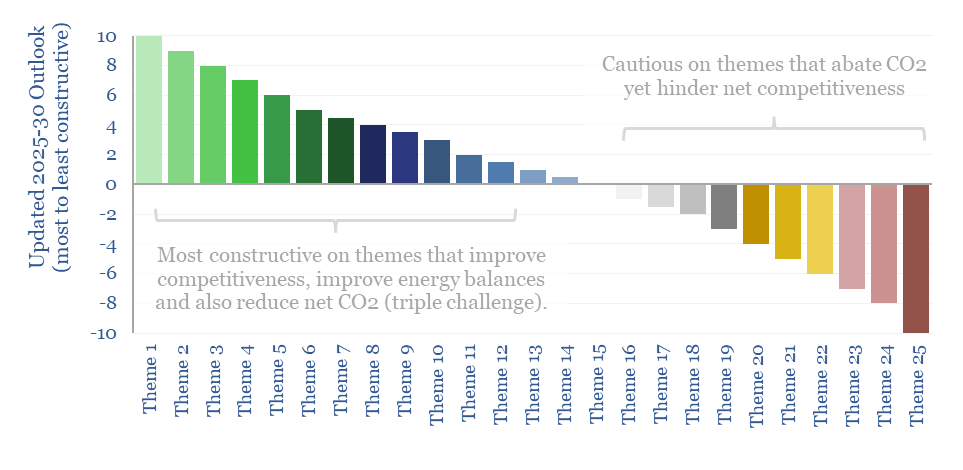Energy transition is a triple challenge: to meet energy needs, abate CO2 and increase competitiveness. History has now shown that ignoring the part about competitiveness gets you voted out of office?! We think raising competitiveness will be the main focus of the new administration in the US. So this 15-page report discusses overlooked angles around energy competitiveness, and updates our outlook for different themes.
A common framework is to call the energy transition a “dual challenge”. The first task is meeting the energy needs of human civilization. And the second task is abating the world’s CO2 emissions. But we increasingly think this framework is incomplete. Energy transition is a triple challenge. The third component is raising competitiveness.
If we only solve for energy supply and CO2 reduction, then there is a danger of backing technologies that achieve both of these things at very high costs; which inflates living costs for consumers, and worsens competitiveness in countries that adopt them (pages 2-3).
The distinction between CO2 abatement and competitive CO2 abatement is illustrated by contrasting CCS and nature-based solutions, in a detailed case study on pages 4-6.
It is really worth thinking about this distinction. Our sense is that the incoming Trump administration is not anti-decarbonization per se. It is simply pro-competitiveness. Hence, we have re-visited our outlook for energy markets and energy transition themes from this lens.
How can developed world economies improve their competitiveness with emerging world economies that have lower labor costs, lower energy costs, and lower environmental costs? Our answer hinges on minimizing the difference in energy costs, then producing better products, via better technology, helped by better infrastructure (page 7).
High-quality infrastructure clearly boosts competitiveness, but can it also be considered an energy transition category? A fiber optic cable moves 1 GB of data with 15,000x less energy than physically transporting it. Bridges, canals, railways and transmission lines save MT-scale CO2. Examples and case studies are on pages 8-10.
Boosting the competitiveness of an industrial economy is helped by selecting low-cost sources of energy and de-selecting expensive ones. Hence, we revisit our electricity cost curves. Especially in the US, we grow more constructive on gas production, gas pipelines, gas turbines on pages 11-12.
Some solar and onshore wind deployments genuinely can improve the competitiveness of energy systems, when deployed in the right place, and in the right quantities. Our outlook for renewables under the new US administration is on page 13.
Incentivizing new technology is another area where we think the new US administration may introduce surprising policies. One proposal that resonates with us is a “first mover tax credit” to help companies justify investments that will de-risk new technologies that later benefit others. Technologies that excite us are re-capped on pages 14-15.
